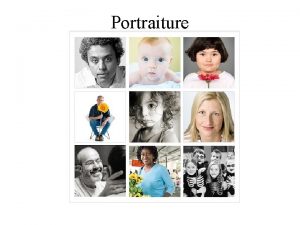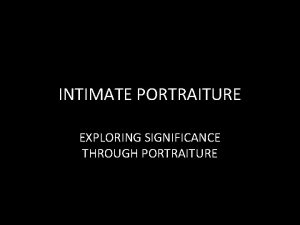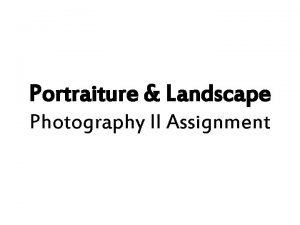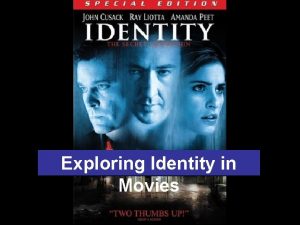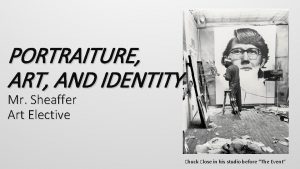Exploring Portraiture and Identity A representation of the







- Slides: 7

Exploring Portraiture and Identity 'A representation of the external form of an object…the character or reputation of a person or thing as generally perceived'. Identity is defined as: 'The quality or condition of being a specified person or thing'. Our individual identity is unique. It combines our genetic being, our cultural, religious and linguistic background, our interests and abilities. It is affected by where and how we live, the country of origin of our parents and grandparents, and what we do with our lives. Young people develop their self-image through seeing how others relate to them and through visual clues. These might range from photos (usually taken by other people) to reflections in a mirror. All this combines with how they feel about themselves and how they interact with the world. A photograph is an image of an individual or a scene at a particular time or place, controlled by the photographer. It is a representation of that event or person and is influenced by what the photographer wants us to see. It is restricted by the photographic technology available at the time. The photographer may wish to introduce aspects of his or her own culture, or views and values that will influence the finished product. Those who view the photos also bring their own knowledge, experience and beliefs, and these will influence their perception of the image.

Challenges Portrait lesson – Choose someone within your group and/or at home(create a studio and location shoot on) and with them explore the work of a portrait photographer who they would like to be photographed in the style of, consider elements of the photographers work and how you will include their style – Lighting, angle, model choice or use of props. You model must be unique to you. Could you tell a story Could you be trying to relate a social message Could it be a fashion piece (David Bailey, Richard Avedon, Eleanor Hardwick, Rankin, Corinne Day)

Object Lesson - Choose one or more objects that represent aspects of your personality. You might decide to select objects from a particular location e. g. your bedroom. Experiment with a variety of ways of photographing these objects and present the Resulting images imaginatively. (Edward Weston / Vee Speers) The power of media to influence people's identities. ' Create portraits using different body parts these could be created by using magazine cut-outs or downloaded Images, how differently would you be perceived if your facial features were changed or you took on characteristics of someone famous or someone else. Bruno Metra and Lawrence Jeanson are behind the concept

The Mask - Choose a disguise or mask and photograph yourself or a friend/family Member wearing it. Consider the ways in which a disguise might reveal, rather than hide, Aspects of your personality. (, Cindy Sherman, Inge morath, Ralph Eugene Meatyard)

Rear View - Photograph people from behind and/or the backs of people's heads. You May decide to include your shadow in these images or focus on unusual/surprising Details. Edit and sequence these images to create a coherent portfolio. (Lee Friedlander, Sophie Calle, Lorna Simpson, Joel Meyerowitz)

States of Mind - Create a series of portraits illustrating different states of mind e. g. Boredom, euphoria, wistfulness etc. Experiment with the use of colour and tone, lighting And location and consider the use of titles and other text to support the presentation of The final images. (Francesca Woodman, Diane Arbus)

Just Do It - Create a series of images representing verbs such as eating, sleeping, Laughing, crying, and walking. Consider the different ways in which these actions can be Represented photographically. (John Baldessari, Richard Long, Andy Goldsworthy, Francis Alÿs, Robin Rhode)








